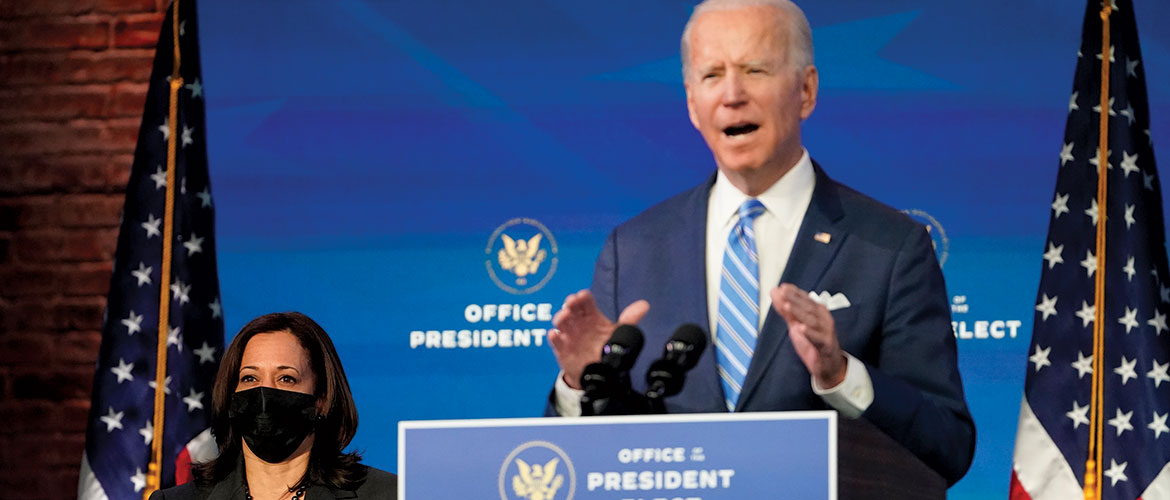The Biden administration’s legislative ideas are coming into sharper focus, starting with a $1.9-trillion coronavirus “rescue” plan that includes only a small list of construction-related provisions. But what has captured construction executives’ interest is the second item on incoming President Joe Biden’s Capitol Hill agenda: an economic recovery proposal due in February that Biden says will “make historic investments in infrastructure, along with manufacturing, research and development and clean energy.”
The new administration will also seek other legislation and revamp regulatory policies in areas such as the environment and labor relations, industry officials say.
Once the recovery plan is fleshed out in legislative text, it still must win approval on Capitol Hill. Biden’s proposals face a somewhat smoother path there than Democrats feared a few months ago, thanks to wins in Jan. 5 runoffs in two U.S. Senate races in Georgia. The victories resulted in a 50-50 party split in the chamber, where new Vice-President Kamala Harris will hold the tie-breaking vote.
It also gives Democrats the ability, in certain circumstances, to bypass the 60-vote threshold for ending a filibuster by using budget reconciliation, which allows bills to proceed with just a simple majority. The House remains in Democrats’ hands, but with a margin that has narrowed to only 11 votes.
A Senate controlled by Democrats means “change in chairmanships, change in staff and change in priorities,” says Michele Stanley, National Stone, Sand & Gravel Association vice president for government and regulatory affairs. Democrats’ slim Senate majority “means these priorities will not be accomplished without a lot of consensus,” Stanley adds.
Steve Hall, American Council of Engineering Companies’ senior vice president for advocacy, says Democrats’ Senate edge “allows [Biden] I think to be a bit more aggressive and to shape the start of the conversation—in terms of the legislative agenda—more to his liking.” But Hall says, “The president is going to need Republicans on his side to move the big stuff forward that becomes law.”
A Key Deadline
Construction officials say they hope 2021 will finally be the year when Congress approves the biggest of that “big stuff”—a long-term infrastructure bill with as much total funding as politically possible.
Biden whetted industry appetites in his Jan. 14 rollout of the rescue plan, saying he would present his “Build Back Better recovery plan” before a joint session of Congress in February. Biden said, “It’s time to stop talking about infrastructure and to finally start building an infrastructure so we can be more competitive.”
He said his proposal would produce “millions of good-paying jobs that put Americans to work rebuilding our roads, our bridges, our ports to make them more climate resilient [and] to make them faster, cheaper, cleaner to transport American-made goods across our country and around the world.”
Biden did not provide a price tag for the infrastructure plan, but during the presidential campaign he floated a $2-trillion proposal. Still unknown is how such a proposal would be paid for and how broad its scope will be.
Infrastructure advocates expect the plan’s centerpiece to be a multiyear surface transportation reauthorization. Hall says, “We know that’s going to be the driver.” Highway and transit programs now are operating under a one-year stopgap, which lapses Sept. 30. Hall says that deadline will force legislative action. “It’s got to happen,” he says. “There’s an end date at the end of September.”
Democrats’ Senate control and Biden’s clean energy and other climate-related priorities already are shaping the content and contours of the highway part of the package. The new chairman of the Senate Environment and Public Works Committee, Tom Carper (D-Del.), has signaled he won’t use a $287-billion measure the panel cleared last Congress as a starting point. That bill never advanced to the chamber’s floor.
In drafting a new highway bill, Carper now wants to greatly expand the earlier version’s provisions dealing with climate change, a spokesperson said. He said Carper aims to have the new bill follow Biden’s framework, which includes moving to zero carbon emissions in the transportation sector.
Audrey Copeland, National Asphalt Pavement Association president and chief executive officer, says Biden’s plan will go beyond highways and transit. “I think it’s definitely going to be broader,” she says.
The National Association of Clean Water Agencies (NACWA) also anticipates Biden’s plan will be wide-ranging. Kristina Surfus, managing director for government affairs, said a key NACWA goal is for water to be “front and center” in the package. She adds, “Investment in water closely aligns with related Democratic priorities—building for resilience and advancing environmental justice.”
Biden may push other legislation, too. For example, construction unions are optimistic that a key priority, the Protecting the Right to Organize, or PRO, Act, may make progress in a Congress with Democratic majorities. The bill would make sweeping labor-policy changes, such as ending the prohibition on secondary boycotts. The House passed the PRO Act in 2020 but the Senate didn’t take it up.
Yvette Pena-O’Sullivan, executive director of the Laborers’ International Union of North America , says, “there’s a lot of hope for figuring out a way to move the PRO Act or something like it, so it’s not just a symbolic bill that’s sitting out there,” She adds that “we will see how well the discussions go. It may not look exactly like the PRO Act, but there’s real opportunity to get labor reform done.”
But the bill will face strong opposition from Associated Builders and Contractors and other business groups.
Rescue plan
Biden’s initial legislative priority, however, is his $1.9-trillion “American Rescue Plan.” It seeks to address immediate problems stemming from the persistent coronavirus pandemic. The envisioned legislation would fund activities such as a stepped-up vaccination push, further payments to individuals, extended and increased unemployment benefits, expanded paid family leave, and major funding infusions to state and local governments and schools.
The rescue plan’s only direct construction-related funding is in its $130 billion for K-12 schools. That can go for a variety of purposes, including physical improvements to school facilities, such as upgrading ventilation systems and modifying indoor spaces to allow social distancing. But schools also may choose to use the funds to hire more janitors or counselors, buy personal protective equipment or expand school bus service.
Other provisions could have indirect benefits for construction. The plan’s $350 billion for state and local governments would keep key public personnel on the job, such as police officers and firefighters. But using the money to shore up state and local agencies’ operating budgets could avoid delaying construction projects.
On the regulatory front, the Biden administration is expected to try to undo what critics call the Trump administration’s rollbacks.
Within his first days of office, Biden plans to direct agencies to delay any rules that have not gone into effect, including “midnight rules” President Donald Trump issued in his last days in office. These are likely to include rules to weaken protections for migratory birds and to change the metric for determining “significant” sources of pollution under the Clean Air Act. Biden also can issue executive orders reversing policies Trump put in place through such directives.
Environmental groups also expect the Biden administration to use the Congressional Review Act (CRA) to shift environmental policy in their favor. Under that law, Congress can disapprove rules issued within 60 legislative days of an administration’s end. That covers rules finalized after Aug. 21. One possible Biden target for CRA action is blocking a less-stringent rule on methane emissions. Dan Lashoff, World Resources Institute director, calls repealing that rule a “no brainer.”
But many Trump regulations that affect construction came before the CRA cutoff. “The closer it gets to getting a rule into place, the more limited their options are,” says Melinda Tomaino, Associated General Contractors of America director of environmental services.
Some Trump rules, such as his replacement for the Waters of the United States regulation and revisions to the National Environmental Policy Act, are already being challenged in federal courts. Tomaino says Biden’s administration isn’t likely to continue Trump’s defense of those rules if cases reach the U.S. Supreme Court.
The new administration also can put its stamp on policy through actions that do not involve the lengthy rulemaking process, says Brad Thompson, managing director for strategic initiatives at C2ES, a climate and energy think tank. He says the US Dept. of Energy, for example, could release new energy-efficiency standards.
Thompson also expects the White House Council on Environmental Quality to revisit NEPA changes issued in July, to again place an emphasis on a project’s “cumulative impacts.”
Biden’s stated commitment to addressing social justice inequities will affect pollution regulations, Tomaino says. For example, the US Environmental Protection Agency has been working on a plan to deal with per- and polyfluoroalkyl substances, or PFAS. She says she expects the PFAS focus to “go into overdrive with the new administration.”
Changes in labor-related regulations also could be coming. Eric Dean, general president of the ironworkers’ union, says he wants more US Labor Dept. leadership on addressing COVID-19-related issues, such as safety and health protocols.
“We want them to give us a blueprint for how to navigate something we’ve never dealt with before,” Dean says. “We thought government should provide the leadership.” Under the Trump administration, “all we got were crickets,” he says.
According to Biden’s transition team, his rescue plan would authorize the Labor Dept.’s Occupational Safety and Health Administration to issue a COVID-19 protection standard for workers, presumably including those in construction.
Organized labor, especially the laborers’ union, is cheering Biden’s decision to nominate Boston Mayor Martin J. Walsh, former president of a laborers’ local and a building trades regional executive, as labor secretary. Pena-O’Sullivan says the union also expects to see much more enforcement of labor laws and regulations, including those dealing with wages, independent contractor issues and safety.
Dramatic shifts could come at the National Labor Relations Board. Wilma Liebman, a Democrat who chaired it during the Obama administration, says that under the Trump administration, the board has been staggering in its sweep and its speed in … how many precedents that have been overruled, both by way of adjudication and rulemaking, possibly more than any other in history.” Those changes have favored employers, she says, and drew praise from business groups.
The five-person NLRB now has a 3-1 Republican majority. It has one vacant Democratic seat. A Republican seat will open up in August, at which point Democrats are expected to take the majority.
The ironworkers’ Dean also hopes the new Congress will reach a deal on an approach to help financially ailing multi-employer pension plans; the plans are common in union construction.







Post a comment to this article
Report Abusive Comment